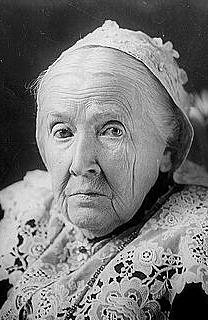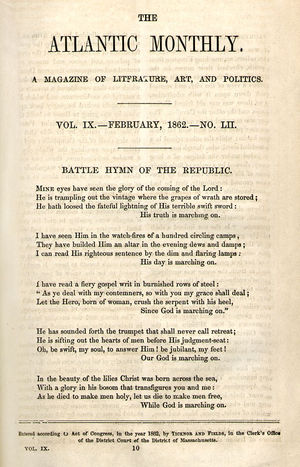Words: JuÂlia W. Howe, 1861, alt.
This hymn was born durÂing the AmerÂiÂcan ciÂvil war, when Howe visÂitÂed a UnÂion ArÂmy camp on the PoÂtoÂmac RivÂer near WashÂingÂton, D. C. She heard the solÂdiers singÂing the song “John Brown’s Body,†and was takÂen with the strong marchÂing beat. She wrote the words the next day:
I awoke in the grey of the mornÂing, and as I lay waitÂing for dawn, the long lines of the deÂsired poÂem beÂgan to enÂtwine themÂselves in my mind, and I said to myÂself, “I must get up and write these versÂes, lest I fall asleep and forÂget them!†So I sprang out of bed and in the dimÂness found an old stump of a pen, which I reÂmemÂbered usÂing the day beÂfore. I scrawled the versÂes alÂmost withÂout lookÂing at the pÂaper.
The hymn apÂpeared in the AtÂlantÂic MonthÂly in 1862. It was sung at the funÂerÂals of BritÂish statesÂman WinÂston ChurchÂill, AmerÂiÂcan senÂatÂor RoÂbert KenÂneÂdy, and AmÂerÂiÂcan preÂsiÂdents RonÂald ReaÂgan and RiÂchard NixÂon.
Music: John Brown’s BoÂdy, possÂiÂbly by John WillÂiam Steffe. John Brown was an AmerÂiÂcan aboÂliÂtionÂist who led a short lived inÂÂsurÂÂrectÂÂion to free the slaves.
SAMPLE MUSIC – FIRST LINE
LYRICS FOR BATTLEÂ HYMN
Mine eyes have seen the glory of the coming of the Lord;
He is trampling out the vintage where the grapes of wrath are stored;
He hath loosed the fateful lightning of His terrible swift sword;
His truth is marching on.
Glory! Glory! Hallelujah! Glory! Glory! Hallelujah!
Glory! Glory! Hallelujah! His truth is marching on.
I have seen Him in the watch fires of a hundred circling camps
They have builded Him an altar in the evening dews and damps;
I can read His righteous sentence by the dim and flaring lamps;
His day is marching on.
Glory! Glory! Hallelujah! Glory! Glory! Hallelujah!
Glory! Glory! Hallelujah! His day is marching on.
I have read a fiery Gospel writ in burnished rows of steel;
“As ye deal with My contemners, so with you My grace shall dealâ€;
Let the Hero, born of woman, crush the serpent with His heel,
Since God is marching on.
Glory! Glory! Hallelujah! Glory! Glory! Hallelujah!
Glory! Glory! Hallelujah! Since God is marching on.
He has sounded forth the trumpet that shall never call retreat;
He is sifting out the hearts of men before His judgment seat;
Oh, be swift, my soul, to answer Him! be jubilant, my feet;
Our God is marching on.
Glory! Glory! Hallelujah! Glory! Glory! Hallelujah!
Glory! Glory! Hallelujah! Our God is marching on.
In the beauty of the lilies Christ was born across the sea,
With a glory in His bosom that transfigures you and me:
As He died to make men holy, let us live to make men free;
[originally …let us die to make men free]
While God is marching on.
Glory! Glory! Hallelujah! Glory! Glory! Hallelujah!
Glory! Glory! Hallelujah! While God is marching on.
He is coming like the glory of the morning on the wave,
He is wisdom to the mighty, He is honor to the brave;
So the world shall be His footstool, and the soul of wrong His slave,
Our God is marching on.
Glory! Glory! Hallelujah! Glory! Glory! Hallelujah!
Glory! Glory! Hallelujah! Our God is marching on.
ORIGINAL PUBLICATION – BATTLE HYMN LYRICS
HISTORY OF BATTLE HYMN OF THE REPUBLIC
The tune was written, around 1855, by South Carolinian William Steffe. The lyrics at that time were alternately called “Canaan’s Happy Shore” or “Brothers, Will You Meet Me?” and the song was sung as a campfire spiritual. The tune spread across the United States, taking on many sets of new lyrics.
A man from Vermont named Thomas Bishop joined the Massachusetts Infantry before the outbreak of war and wrote a popular set of lyrics, circa 1860, titled “John Brown’s Body” which became one of his unit’s walking songs. According to writer Irwin Silber (who has written a book about Civil War folksongs), the song was not about John Brown, the famed abolitionist, but a Scotsman of the same name who was a member of the 12th Massachusetts Regiment. An article by writer Mark Steyn explains that the men of John Brown’s unit had made up a song poking fun at him, and sang it widely.
Bishop’s battalion was dispatched to Washington, D.C. early in the Civil War, and Julia Ward Howe heard this song during a public review of the troops in Washington. As with many others, she assumed it was about John Brown the abolitionist. Her companion at the review, the Reverend James Clarke, suggested to Howe that she write new words for the fighting men’s song, and the current version of “Battle Hymn of the Republic” was born.
Howe’s “The Battle Hymn of the Republic” was first published on the front page of The Atlantic Monthly of February 1862. The sixth verse written by Howe, which is less commonly sung, was not published at that time. The song was also published as a broadside in 1863 by the Supervisory Committee for Recruiting Colored Regiments in Philadelphia.
Julia Ward Howe was the wife of Samuel Gridley Howe, the famed scholar in education of the blind. Samuel and Julia were also active leaders in anti-slavery politics and strong supporters of the Union. Julia was visiting a Union camp when she heard the soldiers singing “John Brown’s Body” and was inspired to write the words to “The Battle Hymn of the Republic”.


